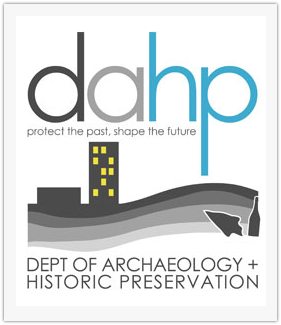DRAFT - 2025–2027 IT Strategic Plan
Protect the Past, Shape the Future
Message from the Chief Information Officer
Information technology is essential to advancing the Department of Archaeology and Historic Preservation’s (DAHP) mission to protect the past and shape the future. As the stewards of Washington’s cultural and historic resources, we must continuously modernize how we manage data, deliver services, and ensure equitable access to preservation tools and information.
This Information Technology (IT) Strategic Plan outlines our goals for strengthening digital infrastructure, enhancing cybersecurity, expanding online access to historic resource data, and empowering both internal teams and external stakeholders through smart technology investments. Aligned with our 2021–2026 State Historic Preservation Plan, this document charts a path forward to leverage IT as a key driver of preservation equity, collaboration, and resilience.
Sincerely,
Morgan McLemore, M.S.ITM
Deputy Director, Chief Information Officer
Washington State Department of Archaeology and Historic Preservation
Vision, Purpose, and Objective
Vision
To be a trusted, innovative, and agile technology partner that empowers DAHP to preserve Washington’s cultural heritage through secure, inclusive, and forward-thinking IT solutions.
Purpose
Provide secure, reliable, and high-quality technology services that support the stewardship of Washington’s historic places, archaeological sites, and cultural traditions.
Objective
Implement technology systems and services that promote historic preservation, streamline operations, enhance digital access, and support statewide equity, tribal partnerships, and customer experience improvements required by EO 25‑06.
Strategic Goals and Key Strategies
Enhance Digital Access to Cultural Resource Data
Modernize and expand the Washington Information System for Architectural and Archaeological Records Data (WISAARD).
Enable mobile and geospatial access for field researchers and public users.
Integrate with WA.gov to support “One Front-Door” access to government services (EO 25‑06).
Prioritize accessibility compliance (WCAG) and multilingual support.
Implement customer feedback loops and plain language improvements.
Strengthen Cybersecurity and IT Resilience
Implement a risk-based cybersecurity framework tailored to cultural resource data.
Conduct triannual cybersecurity audits and annual incident response drills.
Implement established disaster recovery and business continuity systems.
Participate in statewide cybersecurity planning efforts and best practices sharing.
Ensure data sharing agreements comply with privacy mandates and EO’s bias safeguards. Embed governance rules for cross-agency data exchange.
Support Equity and Tribal Digital Partnerships
Develop secure, culturally respectful data-sharing protocols with tribes.
Support digitization of tribal heritage materials through technical assistance.
Expand digital access to cultural resource information to underrepresented communities for resource planning and education.
Expand outreach and feedback channels; support performance metrics disaggregated by demographic groups; ensure equitable service experience.
Foster a Collaborative and Adaptive IT Culture
Continue to incorporate Lean and Agile practices into project delivery and service support.
Improve inter-agency coordination through shared platforms and data exchange.
Provide cross-training and collaboration tools to staff across programs.
Designate a DAHP “Your Washington Liaison” for compliance and reporting.
Invest in IT Workforce and Operational Excellence
Recruit, retain, and grow IT talent with cultural resource expertise.
Provide training in accessibility, plain language, and user-centered design (EO 25‑06).
Cultivate a workplace that embraces diversity, equity, and hybrid work models.
Embed continuous improvement in customer experience through staff development and metrics.
Customer Experience Improvement Program (CEIP)
Develop and implement DAHP’s CEIP within EO timelines (90/120/180 days).
Define customer experience metrics (completion times, satisfaction, feedback response).
Map end-to-end customer journeys for key DAHP services and simplify processes.
Submit quarterly progress reports to Your Washington office.
Performance Metrics
| Metric | Baseline (FY24) | Target (FY25–27) |
|---|---|---|
| WISAARD Uptime | 97.5% | >99.5% |
| CX Feedback Collected (annual) | New | ≥ 100 responses/year |
|
Service Completion Time (avg) |
N/A | Reduce by 25% |
|
Cybersecurity Audit Findings Resolved |
80% | 100% |
|
Public Records Digitized |
5,000+ | 10,000+ |
| Tribal Data Sharing Agreements | 3 | 7 |
| Staff IT Training Hours | 240 hrs. | 360 hrs. |
| Customer Experience Training Completion | N/A | 100% staff by FY26 |
Governance and Alignment
DAHP’s IT strategy is aligned with the Washington State Office of the Chief Information Officer, the Office of Cybersecurity, and Washington Technology Solutions (WaTech). Our approach ensures compliance with statewide Connected Government goals, reinforces DAHP’s contributions to preserving cultural heritage, and supports the Washington State Historic Preservation Plan 2021–2026 by prioritizing equity, accessibility, resilience, and engagement. Integration of Executive Order 25-06 further ensures DAHP participates in the statewide “Your Washington” initiative, with a designated liaison responsible for compliance, reporting, and accountability. Through this alignment, DAHP strengthens its role in Connected Government while delivering preservation services that are efficient, equitable, and customer centered.
State of Washington • Department of Archaeology & Historic Preservation
P.O. Box 48343 • Olympia, Washington 98504-8343 • (360) 586-3065
www.dahp.wa.gov




